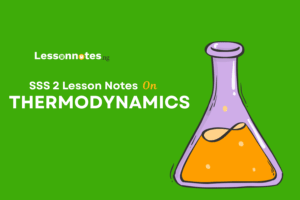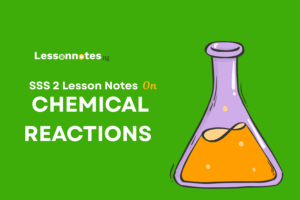Volumetric Analysis SS3 Chemistry Lesson Note
Download Lesson NoteTopic: Volumetric Analysis
SPECIFIC OBJECTIVES: At the end of the lesson, pupils should be able to
- Determine the percentage purity of substances
- Determine water of crystallisation of a solution
INSTRUCTIONAL TECHNIQUES:
- Identification,
- explanation,
- questions and answers,
- demonstration,
- videos from source
INSTRUCTIONAL MATERIALS:
- Videos,
- loudspeaker,
- textbook,
- indicator extracts from flowers,
- Bomb calorimeter,
- acids, and bases.
NOTE
Redox titration count.
In redox titration, the solutions commonly used are the oxidising agents and reducing agents. Examples of oxidising agents include KMnO4, I2, Na2C2O4, and Fe2+.
In acid-base titration, the neutralisation reactions are represented by molecular equations. e.g.
HCl(aq) + KOH(aq) KCl(aq) + H2O(l)
But in redox titrations, only the net ionic equation is represented e.g.
2Mn-4 + 5C2O²-4 + 16H+ 2Mn²+ + 10CO2 + 8H2O
When an oxidising agent (OA) is titrated against a reducing agent (RA) the concentrations of their solutions can be determined as in acid-base titrations.
Example 1
A is a solution on KMNO4, B is 0.02 mol dm³ of ethanediol acid and solution C is 1.0 mol dm³ of the concentrated tetraoxosulphate (VI) acid. Titrate A solution against 25 cm³ of solution B which has been acidified with 5 cm³ of solution C. Average volume of 16.5 cm³ of A was required for complete oxidation of solution B. From the results obtained calculate,
(a) the concentration of solution A in mol dm³
(b) the concentration of solution A in g dm³
Equation of reaction
2Mn-4 + 5C2O²-4 + 16H+ 2Mn²+ +10CO2 + 8H2O
(K = 39, Mn = 55, O = 16)
Solution
(a) CoA x VoA. + nCA
CRA x VRA. nRA
CoA x 16.5 = 2
0.02 x 25 5
CoA = 0.02 x 25 x 2
16.5 x 5. = 0.012112 mol dm³
= 0.0121 mol dm³
(b) Conc in g dm³ of B
The molar mass of KMnO4
= 39 + 55 + 64 + 158 g mol
Mass conc. of A = molar conc. x molar mass
= 0.0121 x 158
= 1.91 g dm³
NOTE: In this redox titration, add KMNO4 from the burette until the solution is permanently pink, that is the endpoint.
KMNO4 is a useful oxidising agent. However, it has the disadvantage that it is sometimes too strong. For example, it will oxidise chloride ions to chlorine
2Cl- Cl2 + 2e-
It must not be used in the titrations if chloride is present. In this case, a weaker oxidising agent must be used and potassium heptaoxodichromate (VI) is a suitable one
Cr2O²-7 + 14H + 6e- 2Cr³+ + 7H2O
The chromate ion is yellow and chromium(III) salt is green, so there is not a sharp end point as with KMNO4. In this case, an indicator must be used and a common one is diphenylamine. The reduced form is colourless, while the oxidised form is dark blue.
Percentage purity
Volumetric analysis is often used to determine the purity of substances (usually expressed as percentage purity). It is especially useful in determining the amount of dissolved impurities in water from various sources.
Example 2. 12 g of a mixture of anhydrous sodium trioxocarbonate (IV), Na2CO3, and sodium chloride, NaCl were made up to 1 dm³ of aqueous solution. 25 cm³ of this mixture was neutralised by 0.2M hydrochloric acid, HCl.
Calculate the mass of the sodium chloride impurity. Find also the percentage purity of trioxocarbonate IV samples. (Na2CO3 = 106, HCl = 36.5)
Equation of reaction
Na2CO3 (aq) + 2HCl(aq) 2NaCl(aq) + H2O (l) + CO2 (g)
mole ratio 1 : 2
CAVA. = NA. mole ratio of acid
CBVB. NB base
= 0.2mol dm-¹ x 20 cm³ CB. = 2
CB x 25 1
CB = 0.2 x 20
25 x 2 = 0.08 mol dm³
i.e. molar mass of Na2CO3 = 0.08 mol dm3
Mass concentration of Na2CO3 = 0.08 x 106 = 8.48g dm³
p = C x M = 0.08 mol dm³ 106 g/mol
= 8.48 g dm³
Therefore, mass of NaCl impurity = 12 – 8.48 = 3.52g
Percentage purity of the Na2CO3 sample
= 8.48. x 100%
12
= 70.7%
Molar mass, water of crystallisation, and solubility of the substance
Volumetric analysis can be used to calculate
(a) the molar mass of the metal acid, or base;
(b) the number of molecules of water of crystallisation of a hydrate,
(c) the solubility of a substance in water.
Example 3. Some crystals of washing soda were exposed to the atmosphere for efflorescence to take place. 60g of this partly effloresced washing soda, Na2CO3.yH2O, were dissolved in the 500cm³ of water. 25cm3 of this trioxocarbonate IV solution is required 32.10 cm³ of 0.097 mol dm³- hydrochloric acid, HCl, for complete neutralisation. Calculate y. Hence, write the formula of the effloresced washing soda.( Na = 23, H = 1, C = 12, Cl = 35.5, O = 16)
Equation of reaction
Na2CO3.yH2O(s) + 2HCI(aq) 2NaCl(aq) + H2O (l) + CO2(g) + yH2O(l)
mole ratio 1 : 2
CAVA = 2
CBVB. 1
0.097 x 32.1. = 2
- C x. 25. 1
CB = 0.097 x 32.1
2 x 25
= 0.0623 mol dm³
Therefore, molar concentration of Na2CO3.yH2O = 0.0623 mol dm³
Mass concentration of Na2CO3.yH2O = 6.02 x 1000
500
= 12.04 g dm³
Molar mass of Na2CO3.yH2O = (106 + 18y) g
Molar mass = mass concentration
molar concentration
= M = C
C
106 + 18y = 12.04
0.0623
18y = 87.3
y = 4.9
Therefore, the formula of the effloresced washing soda is Na2CO3.yH2O
EVALUATION: A solution of trioxonitrate(V) acid contained 0.67g in 100cm³. 31.0 cm³ of this solution neutralised 25cm³of a sodium trioxocarbonate IV solution. Calculate the concentration of the trioxocarbonate IV solution. (HNO3 = 63, Na2CO3 = 106)
CLASSWORK: As in evaluation
CONCLUSION: The teacher commends the students positively





















